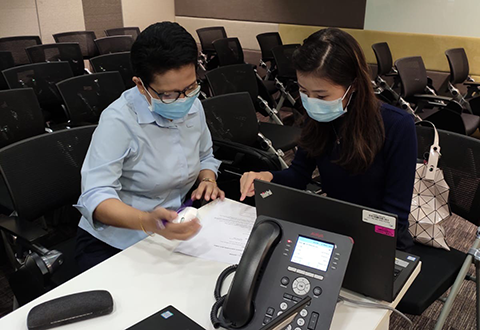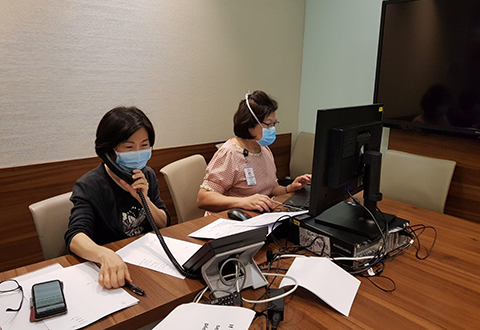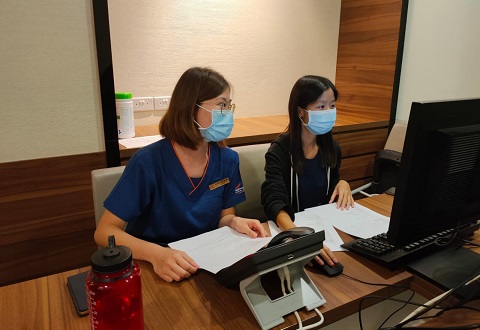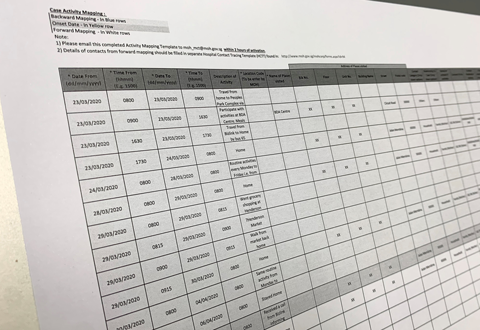When Dorscon Orange was announced in mid-February, Kym Ng from Office of Patient Experience, found a major responsibility crash landing on her – that is, to lead the contact tracing team in NHCS.
The superwomen of the NHCS contact tracing team: (L-R) Kym Ng, Office of Patient Experience; Tang Yi Wei, Human Resource; Lum Luh Na, CTRO; Haslinda Binte Hashim, Support Services; Wong Huay Lan, Finance; and Goh Pei Xuan, Cardiac Laboratory.
When Dorscon Orange was announced in mid-February, Kym Ng, Assistant Manager from Patient Liaison Service, Office of Patient Experience, found a major responsibility crash landing on her – that is, to lead the contact tracing team in NHCS.
“It was a period where the cases starting picking up and more staff volunteers were needed to manage the contact tracing work on SGH Campus. There is currently a total of six NHCS staff involved,” said Kym.
As the cases streamed in steadily, newly recruited contact tracers like Kym had to learn quickly on the job, “Time was not on our side. We learnt through a crash course – picking up skills and knowledge on the job through buddying up with staff from SGH Infection Prevention & Epidemiology Department (IPE) and observing what they do.” Kym shared that during peace times, such trainings are conducted half-yearly and contract tracers will have hands-on practice to login into various systems to extract and collate information required by MOH.
A pioneering team
Among the six on the current team, two were recruited as early as 2003 during SARS. Kym said that team members like Wong Huay Lan from Finance and Lum Luh Nah from Clinical & Translational Research Office (CTRO), were on the pioneer team.
.png)
NHCS Command Centre at level 7 of NHCS Building serves as the hotspot for our contact tracers when handling staff cases.
“A fun fact that I learnt when I joined the team was that NHCS was one of the first national centres to form a contact tracing team. With the ongoing pandemic, we even have our own command centre at level 7 of NHCS building to handle staff cases.”
The first case
Barely a few weeks into her new role, Kym was activated for a suspected Covid-19 case in the Cardiac Catheterisation Laboratory in NHCS.
“Fear and tension was in the air as staff were worried and wondered if it was safe for them to stay in the lab or to even go home. After all the investigations and interviews, we informed SGH control room of the situation. I also stayed behind in the lab to address staff concerns and compiled the information that would need to be submitted to MOH within the next two hours. It was the first ‘case’ we had at NHCS and everyone was on their toes.”
“The very next day when we were informed that the suspected patient’s swab result came back negative, we all heaved a sigh of relief!”
The contact tracing journey
To have a better sense of what a contact tracer does, we followed Kym and her team on a recent case they had.
Quick response upon activation
5.15pm: Arrived at SGH control room and ready to go

Contact tracers reviewing patient’s case history.
Upon an activation at 5pm, the team immediately gathered at the SGH control room located at Block 4, Learning Space in 15 minutes, ahead of the stipulated protocol of reporting within 30 minutes and one hour of activation during and after office hours respectively. The first task at hand was to read and be familiarised with the patient’s case history.
Daily activities matter
5.30pm: Interview begins

Depending on resources available and adhering to safe distancing measures, contact tracers may work in maximally, two-person teams during the interview process, covering and complementing each other’s work.
The real crunch began as the team called and interviewed the patient. The contact tracers have to ‘walk through’ with the patient and trace back every single activity including where the patient had been to and whom he had met, two weeks prior to onset of symptoms and from symptoms onset until being isolated.
Kym shared that in instances where they were unable to reach the patient from the control room, the contact tracer will proceed to the ward where the patient is admitted and attempt to interview over the phone at the nearest nursing counter. She added that this practice is usually not common, “For safety reasons, we only head to the isolation ward when the patient cannot be contacted repeatedly from the control room. Factors such as noise from the surrounding activities in the ward make it challenging to communicate clearly as well.”
Detailed activity mapping
6.25pm: 35 minutes left on the clock to submit the contact tracing report to MOH

The duo bands together to complete the activity map for submission to MOH within the tight timeline.
“Each activity is recorded into an activity map with precise description such as the full address of a shop or location visited, bus or vehicle number, right down to the time the transport was taken. Not a single detail is to be missed! If the patient is unable to recall certain information, we will call his/her family members, and if the patient is a staff, we will call the supervisor,” Kim shared that there was an activity map that had to be tracked over a six week period – the longest she had encountered thus far.

The activity map captures extremely detailed and minute information, each critical to the success of contact tracing efforts (note: sensitive information has been omitted for privacy reasons).
She added that a detailed activity map is crucial in providing the IPE doctors sufficient information to assess the likelihood and risk of infection exposure, and determine the appropriate actions to be taken, for example, home isolation for persons who have had contact with the index patient, or the areas that require terminal cleaning if a staff is involved.
“The only challenge is we might get activated late at night and have to reach out to the patient’s family or supervisor for details at odd times, and they may not pick up our calls promptly. This would impact the turnaround time for reporting to MOH.”
Collaboration triumphs
“My experience has been very positive. Those whom I have interviewed, be it locals or foreigners, were cooperative and well aware that their information is important for the safety of everyone. Perhaps it helped that we always assure them that all information are kept strictly confidential and used mainly for contact tracing purposes,” Kym shared.
The contact tracing role may have crash landed on Kym and had her treading in foreign waters, but she sure dealt with it with composure and positivity, much like the heroine of the similarly-named Korean hit drama.
Thank you to our NHCS contact tracers for doing us proud and keeping us safe!
